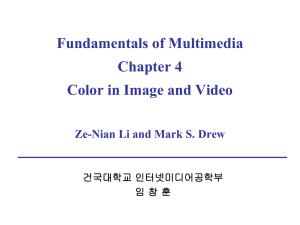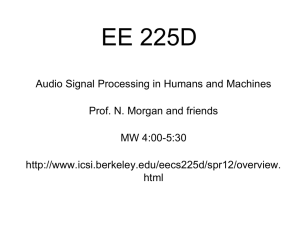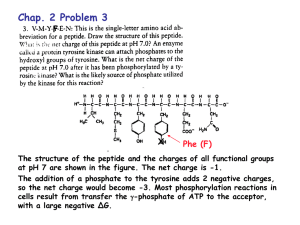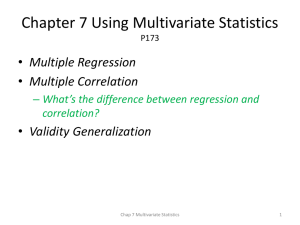Chapter 5. Fundamental concepts in video
advertisement
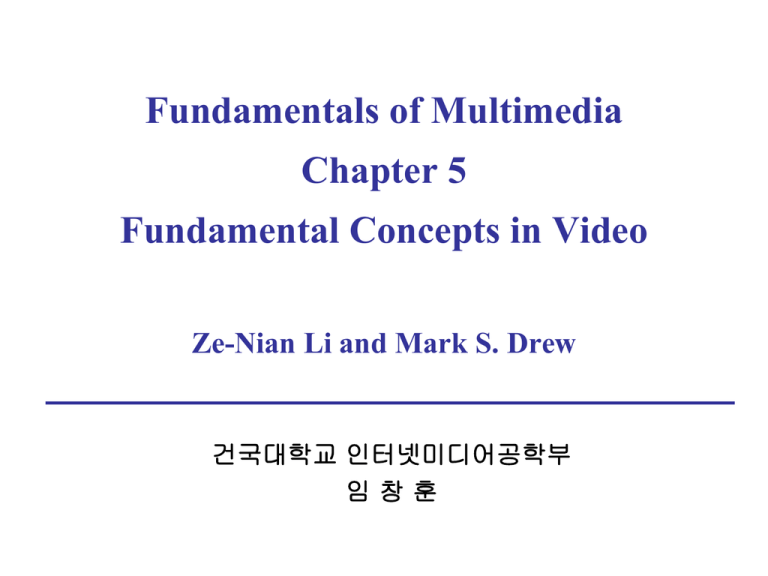
Fundamentals of Multimedia Chapter 5 Fundamental Concepts in Video Ze-Nian Li and Mark S. Drew 건국대학교 인터넷미디어공학부 임창훈 Outline 5.1 Types of Video Signals 5.2 Analog Video 5.3 Digital Video Chap 5 Fundamental Concepts in Video Li & Drew; 인터넷미디어공학부 임창훈 2 5.1 Types of Video Signals Component video Composite video S-Video Chap 5 Fundamental Concepts in Video Li & Drew; 인터넷미디어공학부 임창훈 3 Component Video Higher-end video systems make use of three separate video signals for the red, green, and blue image planes. Each color channel is sent as a separate video signal. Most computer systems use component video, with separate signals for R, G, and B signals. Component video gives the best color reproduction since there is no crosstalk between the three channels. Component video requires more bandwidth and good synchronization of the three components. Chap 5 Fundamental Concepts in Video Li & Drew; 인터넷미디어공학부 임창훈 4 Composite Video Color (chrominance) and intensity (luminance) signals are mixed into a single carrier wave. Chrominance is a composition of two color components (I and Q, or U and V). In NTSC TV, e.g., I and Q are combined into a chroma signal, and a color subcarrier is then employed to put the chroma signal at the high-frequency end of the signal shared with the luminance signal. The chrominance and luminance components can be separated at the receiver end. Chap 5 Fundamental Concepts in Video Li & Drew; 인터넷미디어공학부 임창훈 5 Composite Video When connecting to TVs or VCRs, composite video uses only one wire and video color signals are mixed, not sent separately. Since color and intensity are wrapped into the same signal, some interference between the luminance and chrominance signals is inevitable. Chap 5 Fundamental Concepts in Video Li & Drew; 인터넷미디어공학부 임창훈 6 S-Video - 2 Signal As a compromise, (separated video, or Super-video) uses two wires, one for luminance and another for a composite chrominance signal. As a result, there is less crosstalk between the color information and the crucial gray-scale information. Chap 5 Fundamental Concepts in Video Li & Drew; 인터넷미디어공학부 임창훈 7 5.2 Analog Video An analog signal f(t) samples a time-varying image. So-called progressive scanning traces through a complete picture (a frame) row-wise for each time interval. In analog TV, interlaced scanning is used. The odd-numbered lines are traced first, and then the even-numbered lines are traced. This results in odd and even fields - two fields make up one frame. Chap 5 Fundamental Concepts in Video Li & Drew; 인터넷미디어공학부 임창훈 8 Analog Video Fig. 5.1: Interlaced raster scan Chap 5 Fundamental Concepts in Video Li & Drew; 인터넷미디어공학부 임창훈 9 Analog Video The odd lines (starting from 1) end up at the middle of a line at the end of the odd field, and the even scan starts at a half-way point. First the solid (odd) lines are traced, P to Q, then R to S, etc., ending at T; then the even field starts at U and ends at V. The jump from Q to R and so on is called the horizontal retrace, during which the electronic beam in the CRT is blanked. The jump from T to U or V to P is called the vertical retrace. Chap 5 Fundamental Concepts in Video Li & Drew; 인터넷미디어공학부 임창훈 10 Fig. 5.2: Interlaced scan produces two fields for each frame. (a) The video frame, (b) Field 1, (c) Field 2, (d) Difference of fields Chap 5 Fundamental Concepts in Video Li & Drew; 인터넷미디어공학부 임창훈 11 NTSC Video NTSC (National Television System Committee) TV standard is mostly used in North America and Japan. It uses the familiar 4:3 aspect ratio (the ratio of picture width to its height) and uses 525 scan lines per frame at 30 frames per second (fps). NTSC follows the interlaced scanning system, and each frame is divided into two fields. Chap 5 Fundamental Concepts in Video Li & Drew; 인터넷미디어공학부 임창훈 12 Fig. 5.3 Electronic signal for one NTSC scan line. Chap 5 Fundamental Concepts in Video Li & Drew; 인터넷미디어공학부 임창훈 13 Fig. 5.4: Video raster, including retrace and sync data. Chap 5 Fundamental Concepts in Video Li & Drew; 인터넷미디어공학부 임창훈 14 NTSC Video NTSC uses the YIQ color model, and the technique of quadrature modulation is employed to combine I (in-phase) and Q (quadrature) signals into a single chroma signal C (color subcarrier): NTSC composite signal: Chap 5 Fundamental Concepts in Video Li & Drew; 인터넷미디어공학부 임창훈 15 NTSC Video Fig. 5.5: Y and C signals in the NTSC spectrum. Chap 5 Fundamental Concepts in Video Li & Drew; 인터넷미디어공학부 임창훈 16 Decoding NTSC Signals The first step in decoding the composite signal at the receiver side is the separation of Y using low-pass filter. The chroma signal C can be demodulated to extract the components I and Q separately. To extract I: 1. Multiply the signal C by 2 cos(Fsct) Chap 5 Fundamental Concepts in Video Li & Drew; 인터넷미디어공학부 임창훈 17 Decoding NTSC Signals 2. Apply a low-pass filter to obtain I and discard the two higher frequency (2Fsc) terms. Similarly, Q can be extracted by first multiplying C by 2 sin(Fsct) and then low-pass filtering. Chap 5 Fundamental Concepts in Video Li & Drew; 인터넷미디어공학부 임창훈 18 5.3 Digital Video The advantages of digital representation for video: • Video can be stored on digital devices or in memory, ready to be processed (noise removal, cut and paste, etc.), and integrated to various multimedia applications. • Direct access is possible, which makes nonlinear video editing achievable as a simple. • Repeated recording does not degrade image quality. • Ease of encryption and better tolerance to channel noise. Chap 5 Fundamental Concepts in Video Li & Drew; 인터넷미디어공학부 임창훈 19 Chroma Subsampling Since humans see color with much less spatial resolution than they see black and white (luminance), it makes sense to decimate (subsample) the chrominance signal. Numbers are given stating how many pixel values, per four original pixels, are actually sent. Chap 5 Fundamental Concepts in Video Li & Drew; 인터넷미디어공학부 임창훈 20 Fig. 5.6: Chroma subsampling. Chap 5 Fundamental Concepts in Video Li & Drew; 인터넷미디어공학부 임창훈 21 Chroma Subsampling The chroma subsampling scheme 4:4:4 indicates that no chroma subsampling is used: each pixel's Y, Cb, Cr values are transmitted, 4 for each of Y, Cb, Cr. The scheme 4:2:2 indicates horizontal subsampling of the Cb, Cr signals by a factor of 2. Chap 5 Fundamental Concepts in Video Li & Drew; 인터넷미디어공학부 임창훈 22 The scheme 4:1:1 subsamples horizontally by a factor of 4. The scheme 4:2:0 subsamples in both the horizontal and vertical dimensions by a factor of 2. Theoretically, an average chroma pixel is positioned between the rows and columns as shown Fig.5.6. Scheme 4:2:0 along with other schemes is commonly used in JPEG and MPEG Chap 5 Fundamental Concepts in Video Li & Drew; 인터넷미디어공학부 임창훈 23 CIF and QCIF CIF stands for Common Intermediate Format specified by the CCITT. The idea of CIF is to specify a format for lower bitrate. It uses a progressive (non-interlaced) scan. QCIF stands for Quarter-CIF. All the CIF/QCIF resolutions are evenly divisible by 8, and all except 88 are divisible by 16; this provides convenience for block-based video coding in H.261 and H.263, discussed later in Chapter 10. Chap 5 Fundamental Concepts in Video Li & Drew; 인터넷미디어공학부 임창훈 24 Table 5.3: Digital video specifications Chap 5 Fundamental Concepts in Video Li & Drew; 인터넷미디어공학부 임창훈 25 HDTV (High Definition TV) The first generation of HDTV was based on an analog technology developed by Sony and NHK in Japan in the late 1970s. MUSE (MUltiple sub-Nyquist Sampling Encoding) was an improved NHK HDTV with hybrid analog/digital technologies. It has 1,125 scan lines, interlaced (60 fields per second), and 16:9 aspect ratio. Since uncompressed HDTV will easily demand more than 20 MHz bandwidth, which will not fit in the current 6 MHz or 8 MHz channels, various compression techniques are being investigated. Chap 5 Fundamental Concepts in Video Li & Drew; 인터넷미디어공학부 임창훈 26 HDTV (High Definition TV) For video, MPEG-2 is chosen as the compression standard. For audio, AC-3 is the standard. The salient difference between conventional TV and HDTV: • HDTV has a much wider aspect ratio of 16:9 instead of 4:3. • HDTV moves toward progressive (non-interlaced) scan. • The rationale is that interlacing introduces serrated edges to moving objects and flickers along horizontal edges. Chap 5 Fundamental Concepts in Video Li & Drew; 인터넷미디어공학부 임창훈 27

